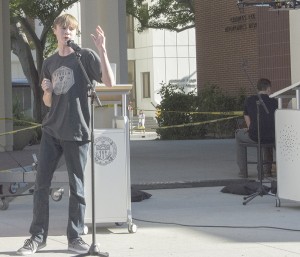HackSC brings entrepreneurs together
USC hosted HackSC, a student-run 36-hour hackathon that promotes quick learning and rapid prototyping this weekend at the Annenberg School for Communication and Journalism.

High flying · Harris Christiansen, a freshman at Purdue University, presents the iDrone at HackSC, which was held at USC this weekend. – Mariya Dondonyan | Daily Trojan
With over 700 participants, including students from Stanford and the University of California Berkeley, HackSC was the biggest hackathon ever held on the USC campus. Participants had access to a variety of resources, including hardware and software tools, and were encouraged to build applications in the fields of game, iOS, Android, web and hardware.
“We wanted to create a community for people who are interested in creating apps and all these projects and who are interested in computer science,” said Ruyan Chen, a junior majoring in computer science who led the marketing efforts for the event.
She said the goal of HackSC is to build a supportive hacker community in the Southern California area.
“We feel like SoCal is going to be a region where tech is growing really fast, so we want to help it move along the right direction,” Chen said.
The weekend-long hackathon began on Friday evening with keynote speaker Pamela Fox, who creates programming curriculum at Khan Academy to teach the next generation of computer science programmers. Fox is a graduate of USC’s computer science department and has worked at Coursera and Google.
After the opening ceremony, participants were able to form teams and pitch ideas to the mentors sent by the industry sponsors of the event. The event also hosted workshops in multiple fields of leading technology, including game development and hardware.
“We started Hacker SChool, which was targeted at new hackers who want to build products in the five major domains, whether it’s iOS, Android, games, web or hardware,” said junior Brian Kim, a founder of HackSC. “The goal was for the participants to learn the full process of building an app after the five hours of training.”
Calvin LeGassick, a project lead for HackSC and a sophomore majoring in computer science and electrical engineering, said he wants to continue Hack SChool for the next year because it’s never been done before at a hackathon and that it did exactly what he and the planning team wanted it to do.
“The feedback we got from the students was that they were able to build cool stuff afterwards, and that’s what the event is about. We want to expand it next year and make sure that all the workshops we did this year are better and more interactive, as well as adding another workshop about 3D printing,” LeGassick said.
LeGassick hopes to expand the hackathon to students in other majors as well.
“Right now, hackathons are primarily for computer science students,” he said. “Something that we’re interested in opening up is for hackathons to be a place to build cool stuff, and that doesn’t necessarily mean software.”
HackSC had over 1,800 people register, but the coordinators had to cut down on the number of participants due to the limited space and budget.
“Though we are bigger than most hackathons, we are still trying to keep the small hackathon feeling in which people are supported and cared for,” Kim said.
Kim said the current computer science curriculum is too theoretical and not application-oriented enough.
“Currently, the computer science curriculum is very theoretical, and it’s very important to have the foundational basis, but if you’re supplementing that with real-life building for [actual] users, that’s extremely important. And that’s definitely something that’s under-emphasized and something we want to bring up,” Kim said.
Robert Hernandez, an assistant professor of professional practice at the Annenberg School, was one of the faculty advisors for HackSC.
“I helped mentor two teams that [were] composed of Annenberg students and who never have done hackathons before,” Hernandez said. “It’s really important for us to be involved in this movement and to also host it as much as we can.”
Hernandez said the hackathon fostered teamwork, collaboration and problem solving, which are skills necessary to succeed in today’s society.
“It’s working under a deadline, it’s problem solving, it’s learning digital skills and applying them, and also coming up with solutions that they didn’t think was possible,” he said. “These are important skills that you don’t necessarily get out of the classroom. This is a different type of environment that should be part of our toolbox and curriculum.”
Samir Ghosh, a freshman majoring in cognitive science, was a first-time participant at the hackathon.
“My project is called Beatbot, and it’s a dynamic drum machine that follows you as you play the guitar,” Ghosh said. “So as you speed up or slow down it keeps tempo with you.”
He and his team used a Myo, which is a motion control and gesture control armband bracelet that utilizes arm muscle activity to control digital devices over Bluetooth, and an Arduino to show a light display of the beat.
“I think events like HackSC will inspire a culture of innovation at USC. We have a ton of brilliant minds, and it’s really cool to see what happens when you put creative people together,” Ghosh said.

